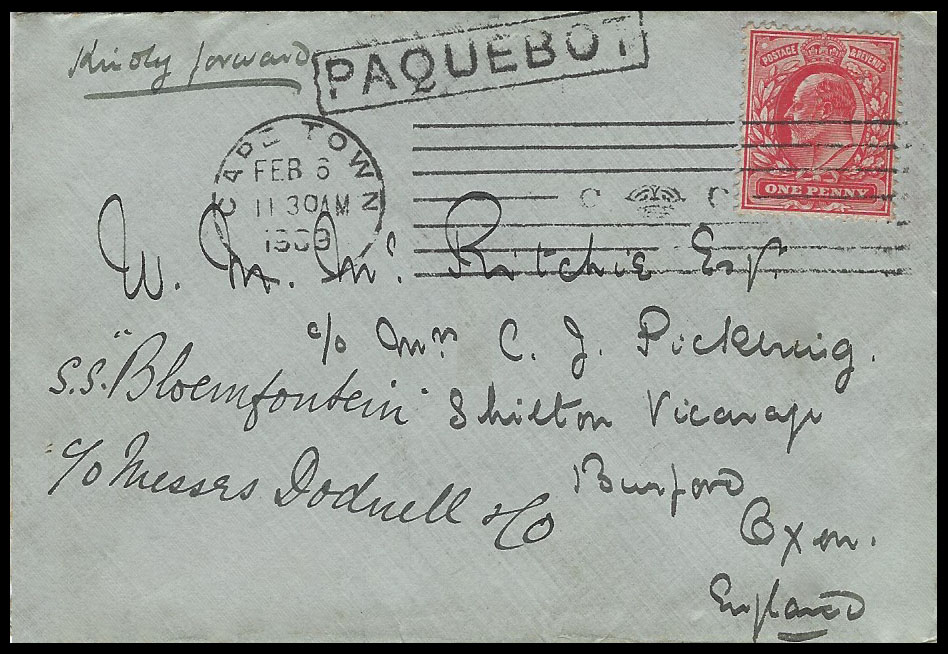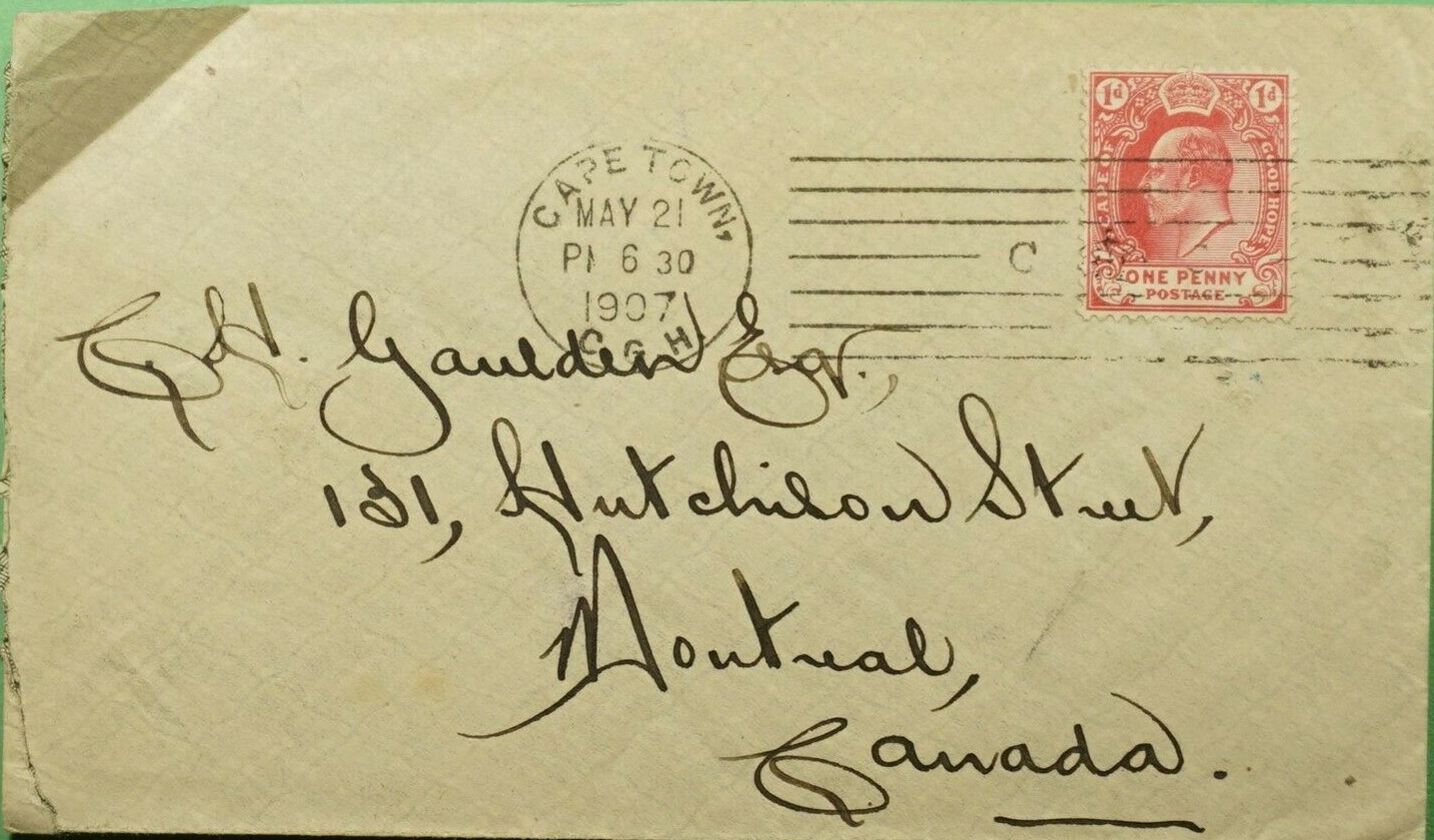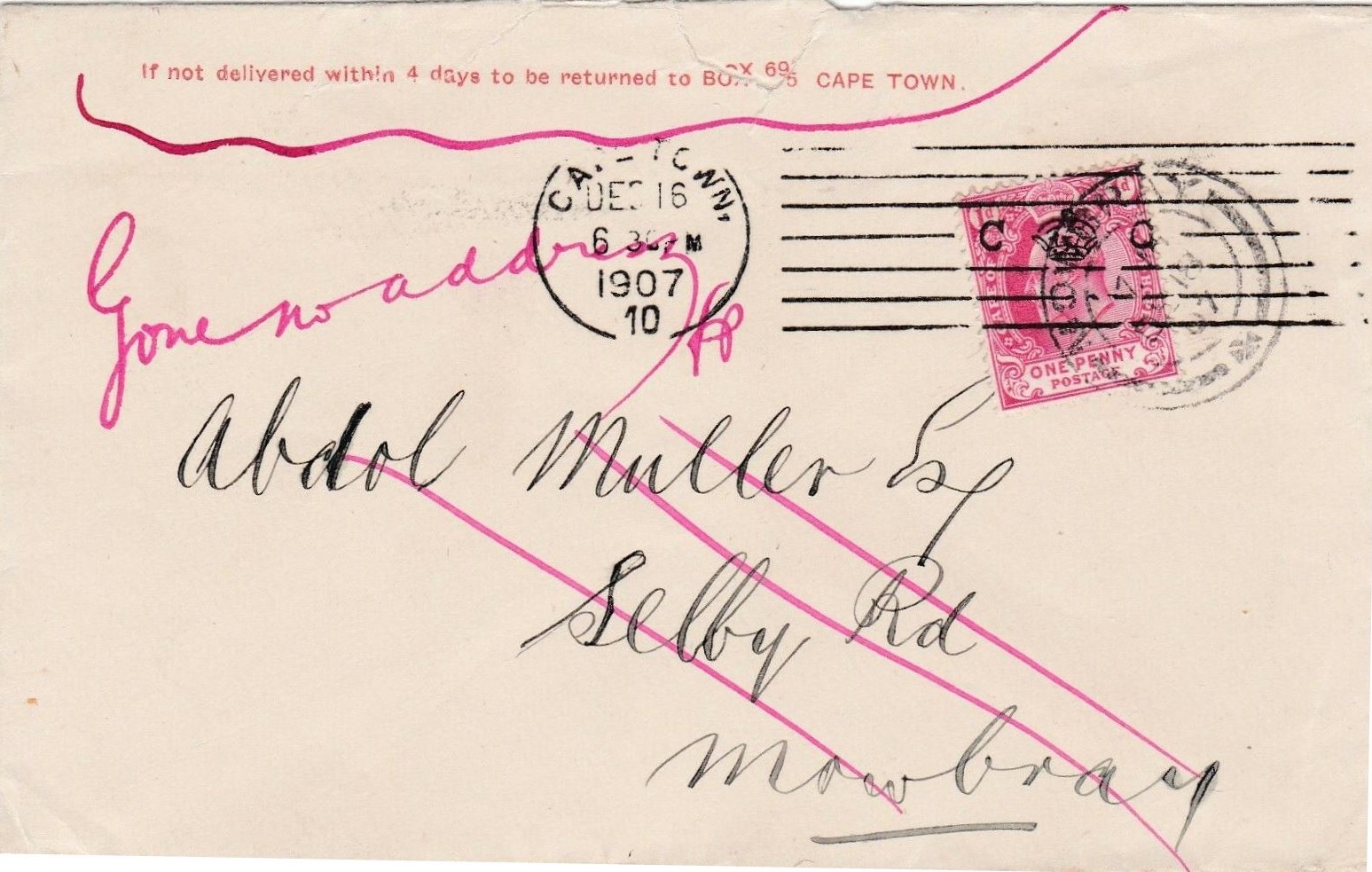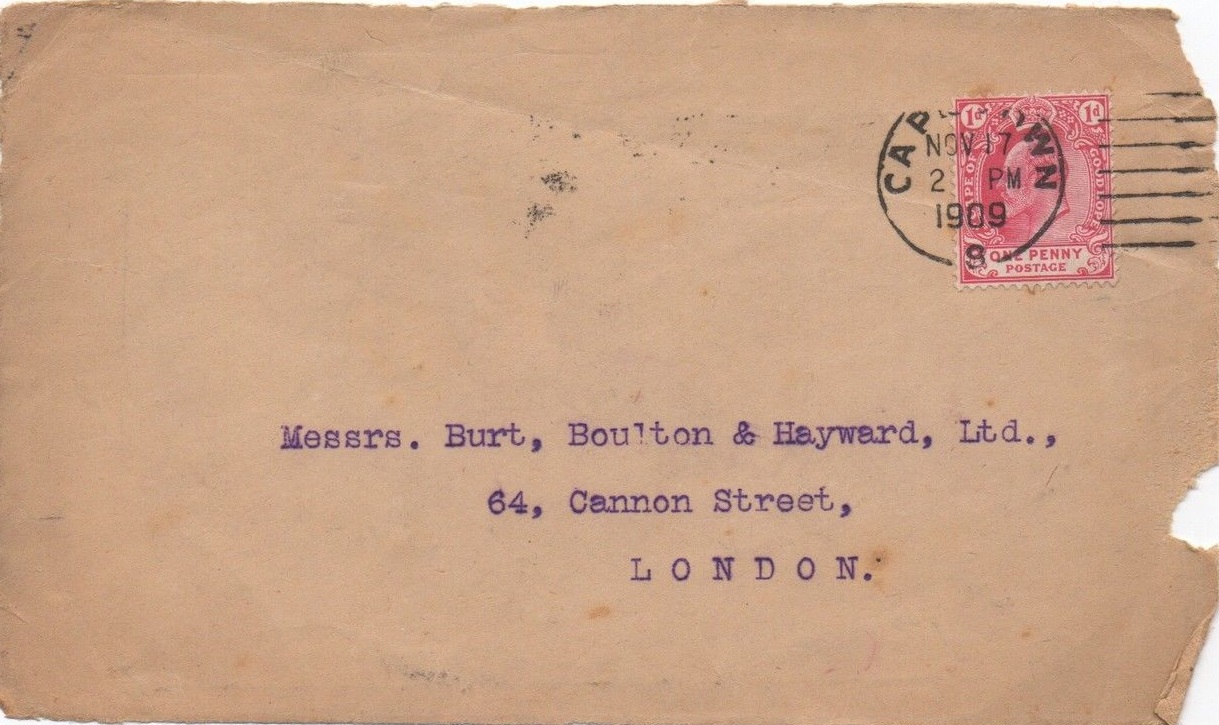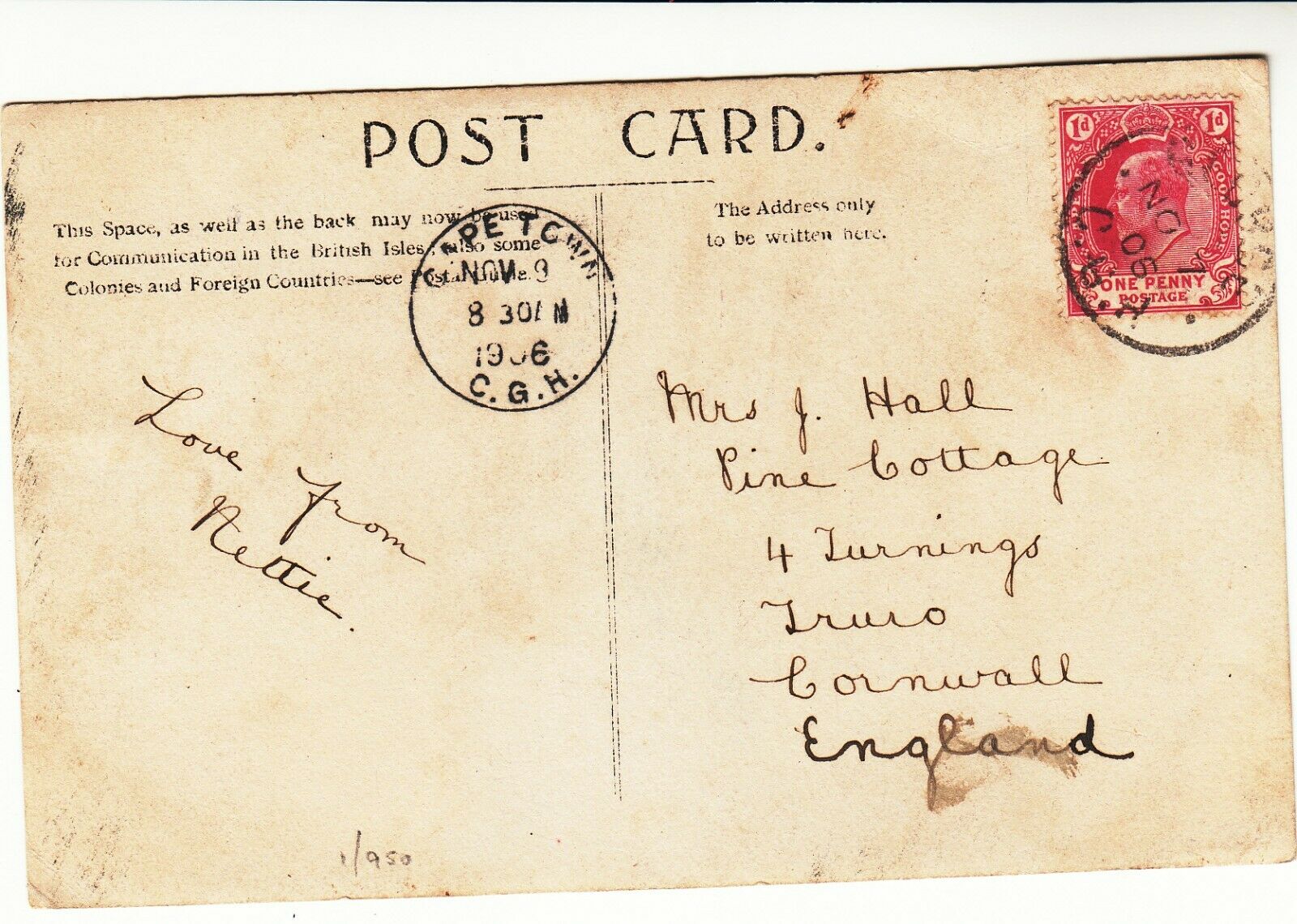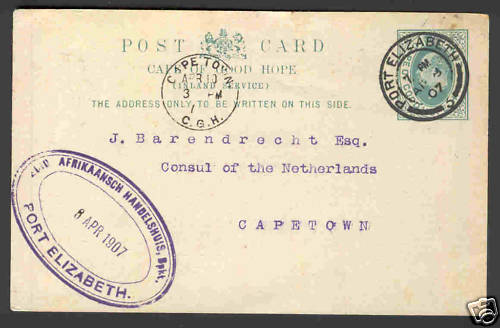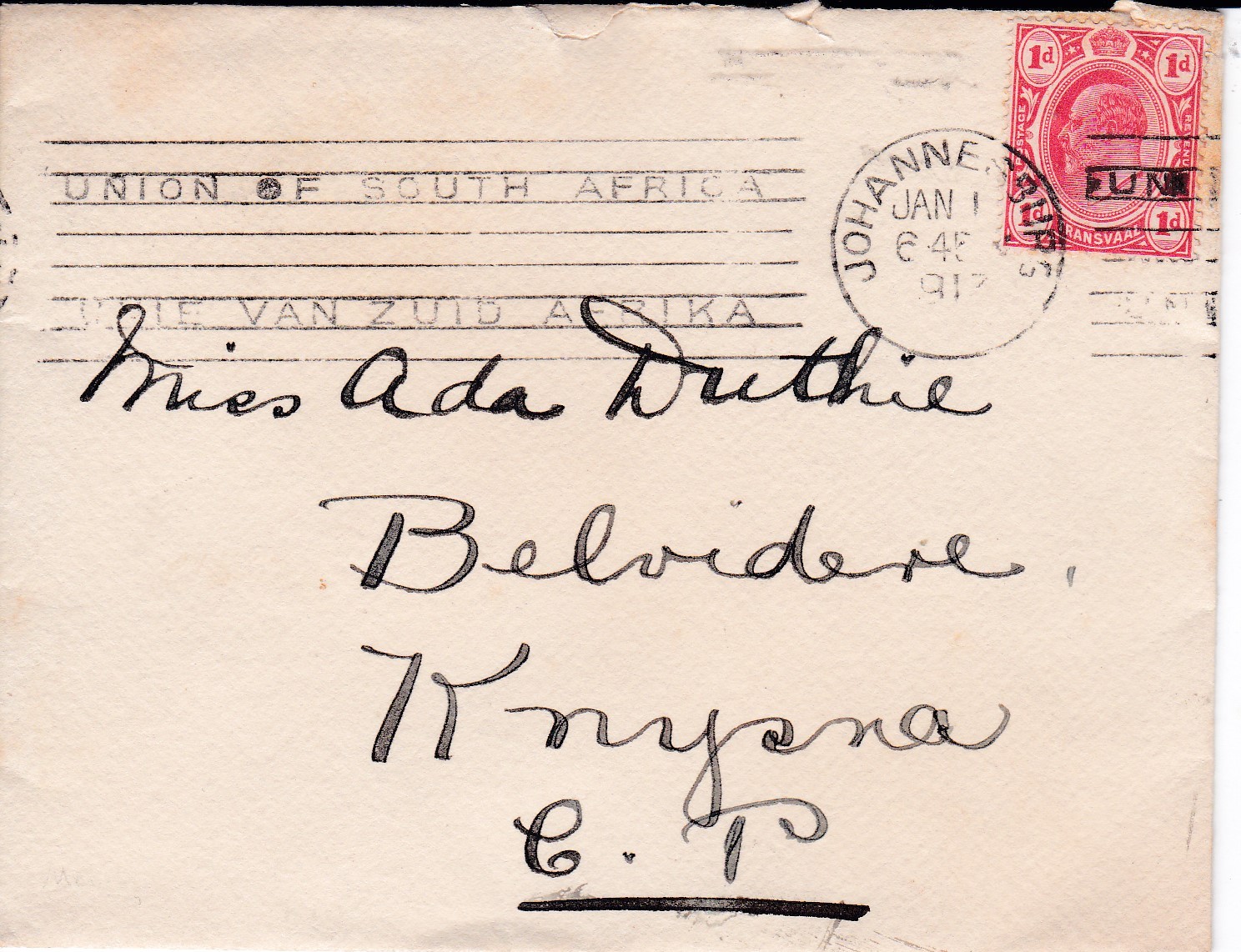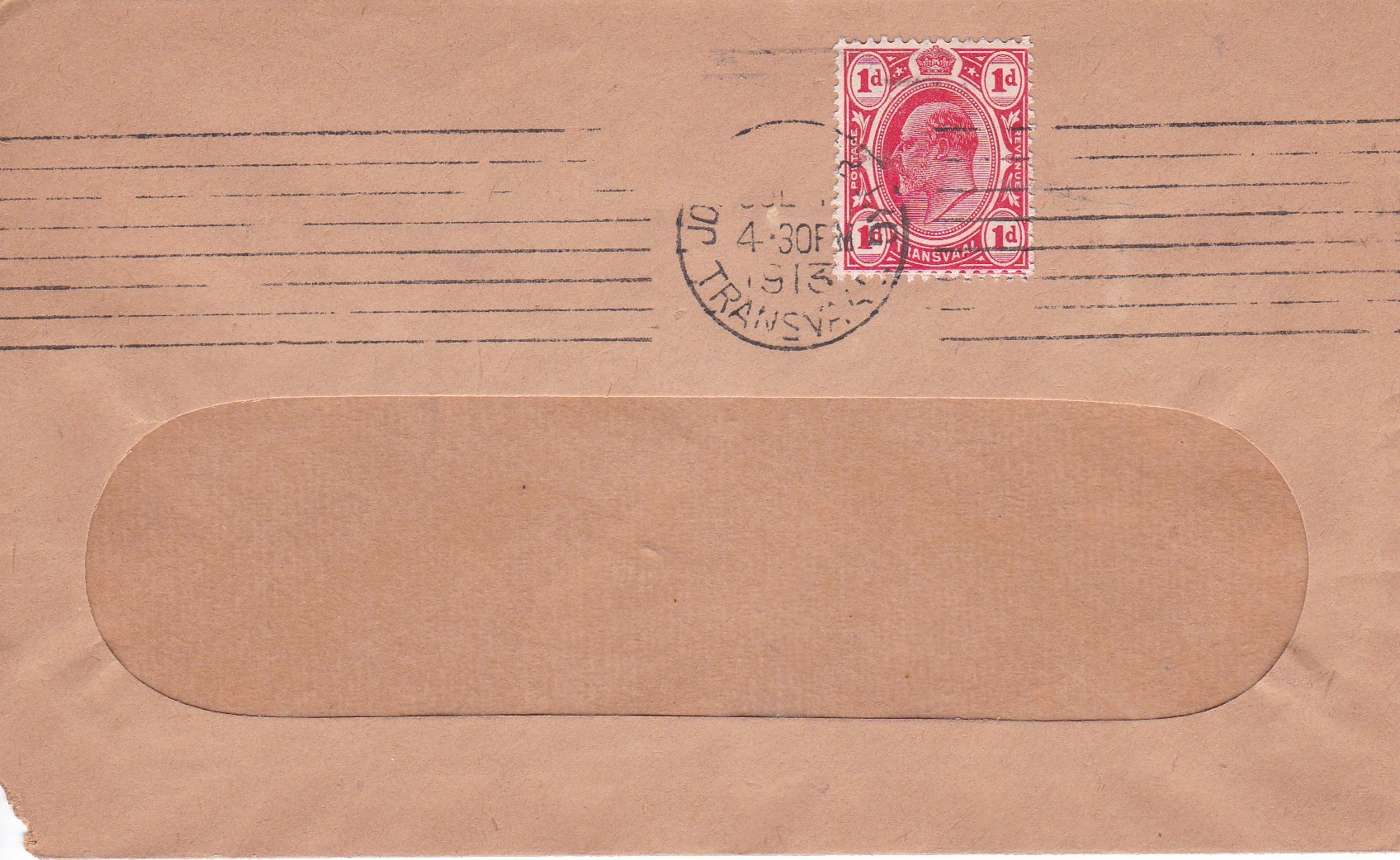Machine Marks
Quote from Steve on March 17, 2021, 3:52 pmI have been working on a display of Paquebot marks and found this. I have had a quick look at Goldblatt and do not see it included. (Putzel does not do machine cancellers.) I believe the year is 1903 which is a year at most after the boxed rectangular 'Omnibus' Paquebot mark was introduced, according to Putzel in 1902. Anyway, the interest here is not this early Paquebot mark but the Machine Canceller. Goldblatt shows no example of this with a small crown and CC that has the datestamp's CAPE TOWN extending from 9 o'clock to 3 o'clock. So, is this an unrecorded example or am I making a fool of myself, again, because this is shown somewhere in the preceding thread?
I have been working on a display of Paquebot marks and found this. I have had a quick look at Goldblatt and do not see it included. (Putzel does not do machine cancellers.) I believe the year is 1903 which is a year at most after the boxed rectangular 'Omnibus' Paquebot mark was introduced, according to Putzel in 1902. Anyway, the interest here is not this early Paquebot mark but the Machine Canceller. Goldblatt shows no example of this with a small crown and CC that has the datestamp's CAPE TOWN extending from 9 o'clock to 3 o'clock. So, is this an unrecorded example or am I making a fool of myself, again, because this is shown somewhere in the preceding thread?
Uploaded files:Quote from Bas PAYNE on March 17, 2021, 8:30 pmSteve:
As you say, Putzel doesn't do machine postmarks, and Goldblatt's listing of them is rather incomplete.
The small CcrownC "flag"was used at Cape Town was in use at least from Nov 1904 until Nov 1909, with at least four different circular date-stamps.
The first three all have "CAPE TOWN," at the top, extending over about 140 degrees:
Type 1: seen between Nov 1904 and May 1907, Goldblatt's MRD2, has "C.G.H." at the bottom.
Type 2: seen in 1906 and rather scarce, Goldblatt's MRD3, has "PAID" at the bottom.
Type 3: seen between Sep 1907 and Dec 1908, Goldblatt's MRD 4 and 5, has a gap at the bottom and no "C.G.H."; often there is a number in the gap (MRD4) - 1, 2, 4, 5, and 10 seen. We don't know what these numbers signify. (Goldblatt's drawing of MRD5 is dated JUN 8 1909; it is substantially later than otherwise seen, and appears to need confirmation by photo or scan.)
The fourth has "CAPE TOWN" extending over more than 180 degrees and without comma
Type 4: seen between Jan 1909 and Nov 1909, and unlisted by Goldblatt, again with a gap at the bottom and often but not always a number on the gap - 1, 2 and 8 seen.
Yours is Type 4; I think the date is probably FEB 5 1909 rather than FEB 5 1903.
I will attach scans of examples of Types 1, 3 and 4, and would welcome reports of dates outside the ranges given, or suggestions about what the numbers mean.
Steve:
As you say, Putzel doesn't do machine postmarks, and Goldblatt's listing of them is rather incomplete.
The small CcrownC "flag"was used at Cape Town was in use at least from Nov 1904 until Nov 1909, with at least four different circular date-stamps.
The first three all have "CAPE TOWN," at the top, extending over about 140 degrees:
Type 1: seen between Nov 1904 and May 1907, Goldblatt's MRD2, has "C.G.H." at the bottom.
Type 2: seen in 1906 and rather scarce, Goldblatt's MRD3, has "PAID" at the bottom.
Type 3: seen between Sep 1907 and Dec 1908, Goldblatt's MRD 4 and 5, has a gap at the bottom and no "C.G.H."; often there is a number in the gap (MRD4) - 1, 2, 4, 5, and 10 seen. We don't know what these numbers signify. (Goldblatt's drawing of MRD5 is dated JUN 8 1909; it is substantially later than otherwise seen, and appears to need confirmation by photo or scan.)
The fourth has "CAPE TOWN" extending over more than 180 degrees and without comma
Type 4: seen between Jan 1909 and Nov 1909, and unlisted by Goldblatt, again with a gap at the bottom and often but not always a number on the gap - 1, 2 and 8 seen.
Yours is Type 4; I think the date is probably FEB 5 1909 rather than FEB 5 1903.
I will attach scans of examples of Types 1, 3 and 4, and would welcome reports of dates outside the ranges given, or suggestions about what the numbers mean.
Uploaded files:
Quote from Steve on March 18, 2021, 10:23 amMany thanks for your advice. Yes, it was wishful of me to hope that the date on the Paquebot cover's MC (machine canceller) was '1903'. Your suggestion that it is '1909' explains why this apparently 'new' Paquebot mark looks so well-used. Sadly, I accept your advice that it is '1909'.
Please advise on the following. I have been told by a Paquebot expert who does not want to list all MCs for fear of going mad that "many machine cancellers had a number of datestamps that were used and added to the actual cancel itself at different times. I am sure that Capetown had a number of different dies kept in a drawer that were taken out and used when needed." Because different MC marks were produced on the same machine canceller, he lists them all under the same number despite obvious variations between them.
I had no idea that some machines were supplied with more than one datestamp. In any event, I always thought a MC with a different circular datestamp should have its mark listed with its own number. However, our expert lists widely differing MCs under the same number (with no a, b or c), and worse, rather than show the original MC, (like the first example from 1915), he shows the second version from 1935 (no doubt, his best example) as the basic type. The description of the original is "circular portion varied!" I am trying to sort this out with examples. By restricting my activties to southern Africa, I remain in the realm of the sanely possible. Just!
Many thanks for your advice. Yes, it was wishful of me to hope that the date on the Paquebot cover's MC (machine canceller) was '1903'. Your suggestion that it is '1909' explains why this apparently 'new' Paquebot mark looks so well-used. Sadly, I accept your advice that it is '1909'.
Please advise on the following. I have been told by a Paquebot expert who does not want to list all MCs for fear of going mad that "many machine cancellers had a number of datestamps that were used and added to the actual cancel itself at different times. I am sure that Capetown had a number of different dies kept in a drawer that were taken out and used when needed." Because different MC marks were produced on the same machine canceller, he lists them all under the same number despite obvious variations between them.
I had no idea that some machines were supplied with more than one datestamp. In any event, I always thought a MC with a different circular datestamp should have its mark listed with its own number. However, our expert lists widely differing MCs under the same number (with no a, b or c), and worse, rather than show the original MC, (like the first example from 1915), he shows the second version from 1935 (no doubt, his best example) as the basic type. The description of the original is "circular portion varied!" I am trying to sort this out with examples. By restricting my activties to southern Africa, I remain in the realm of the sanely possible. Just!
Quote from Bas PAYNE on March 18, 2021, 12:04 pmThe answer to your question depends on understanding a bit about how machine cancellers work.
Most of the machine cancellers used in South Africa between 1910 and 1947 were made by Krag - a Norwegian firm. If you look at the cancellations produced by these machines, you'll see that they are made up of four parts - two date-stamps (usually circular, but sometimes rectangular), and two "flags" - sometimes straight or wavy lines, and sometimes slogans (the fact that there are two "flags" made it simple to accommodate bilingual slogans). The bit that does the cancelling in the machines is a steel cylinder a bit over an inch high, and about two inches in diameter; the "flags" are on two removable "cheek-pieces"; between them the date-stamps - again removable - sit in deeper recesses in the cylinder. As the cheek-pieces and the date-stamps are all removable and replaceable, slogans and date-stamps can be removed and replaced by other slogans and date-stamps, so different combinations are seen. So any attempt at listing has to be able to deal with these different combinations.
The earlier machine that produced the CcrownC cancellation on your paquebot cover was a bit different - it produced a single cds and flag rather than a continuous impression. I haven't seen one of these earlier machines, but it seem likely that there was just one flag and one cds; the different variants reported suggest that the cds was removable and replaceable, and the fact that covers are seen with the cds and no "flag" (generally as a routing or arrival date-stamp as in the attached scans) suggests that the flag was also removeable.
I hope that helps .....
The answer to your question depends on understanding a bit about how machine cancellers work.
Most of the machine cancellers used in South Africa between 1910 and 1947 were made by Krag - a Norwegian firm. If you look at the cancellations produced by these machines, you'll see that they are made up of four parts - two date-stamps (usually circular, but sometimes rectangular), and two "flags" - sometimes straight or wavy lines, and sometimes slogans (the fact that there are two "flags" made it simple to accommodate bilingual slogans). The bit that does the cancelling in the machines is a steel cylinder a bit over an inch high, and about two inches in diameter; the "flags" are on two removable "cheek-pieces"; between them the date-stamps - again removable - sit in deeper recesses in the cylinder. As the cheek-pieces and the date-stamps are all removable and replaceable, slogans and date-stamps can be removed and replaced by other slogans and date-stamps, so different combinations are seen. So any attempt at listing has to be able to deal with these different combinations.
The earlier machine that produced the CcrownC cancellation on your paquebot cover was a bit different - it produced a single cds and flag rather than a continuous impression. I haven't seen one of these earlier machines, but it seem likely that there was just one flag and one cds; the different variants reported suggest that the cds was removable and replaceable, and the fact that covers are seen with the cds and no "flag" (generally as a routing or arrival date-stamp as in the attached scans) suggests that the flag was also removeable.
I hope that helps .....
Uploaded files:Quote from Steve on March 19, 2021, 9:41 amYou are right that I did not know how they worked. Unlike you I have never seen one. But thanks to your advice, I now have a better understanding of them and how they work. In terms of attempting to produce a list of different machine cancellations, where a machine is capable of making multiple different marks its earliest complete mark should become the basic type and all subsequent varieties of this original should be listed as a, b or c. I think this is a minefield where madness is the risk run by those wanting clarity and order. Many thanks for your helpful explanation.
You are right that I did not know how they worked. Unlike you I have never seen one. But thanks to your advice, I now have a better understanding of them and how they work. In terms of attempting to produce a list of different machine cancellations, where a machine is capable of making multiple different marks its earliest complete mark should become the basic type and all subsequent varieties of this original should be listed as a, b or c. I think this is a minefield where madness is the risk run by those wanting clarity and order. Many thanks for your helpful explanation.
Quote from Johan64 on April 2, 2021, 12:44 pmQuote from yannisl on September 12, 2020, 4:36 pmI am opening this thread for machine cancellations, in order to try and understand them better and for other people to add material, thoughts and comments. My original interest was the limited number one can find for the Cape of Good Hope. As information was scarce for some original research, I thought to do what the Cape Postmaster was always doing that is look at what the "mother" country was doing. On the spur of the moment I bought a few covers of machine cancellations of the period. Plus I have a few boxes of GB material which need sorting out. I never really managed to do much about since, but now with this website maybe I can start at the beginning.
The albums are shown below, probably around 600+ items waited to have their stories told. There is very little War II material. Most of the Material is Edwardian when the first slogan appeared "BUY WAR BONDS" and its variants.
Dear sir, you are showing really amazing a quality COGH material, thank you. Does your resources apply to the whole of South Africa or only COGH? I collect Transvaal only, so I will be interesting in any resources that you have available that includes Transvaal. I will also show some Transvaal machine cancellers soon.
Quote from yannisl on September 12, 2020, 4:36 pmI am opening this thread for machine cancellations, in order to try and understand them better and for other people to add material, thoughts and comments. My original interest was the limited number one can find for the Cape of Good Hope. As information was scarce for some original research, I thought to do what the Cape Postmaster was always doing that is look at what the "mother" country was doing. On the spur of the moment I bought a few covers of machine cancellations of the period. Plus I have a few boxes of GB material which need sorting out. I never really managed to do much about since, but now with this website maybe I can start at the beginning.
The albums are shown below, probably around 600+ items waited to have their stories told. There is very little War II material. Most of the Material is Edwardian when the first slogan appeared "BUY WAR BONDS" and its variants.
Dear sir, you are showing really amazing a quality COGH material, thank you. Does your resources apply to the whole of South Africa or only COGH? I collect Transvaal only, so I will be interesting in any resources that you have available that includes Transvaal. I will also show some Transvaal machine cancellers soon.
Quote from Johan64 on April 2, 2021, 12:55 pmThis is an overview of the various machine cancellers that was used in Transvaal, including the early Union period.
This is an overview of the various machine cancellers that was used in Transvaal, including the early Union period.
Uploaded files:
